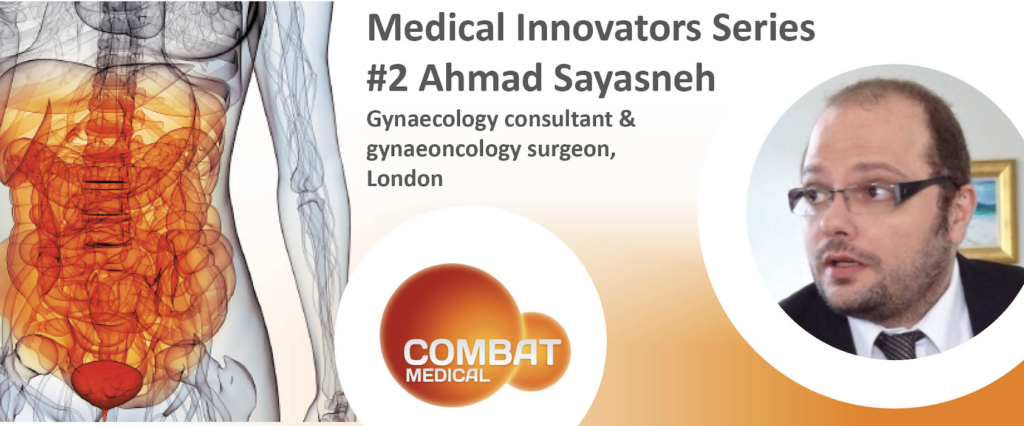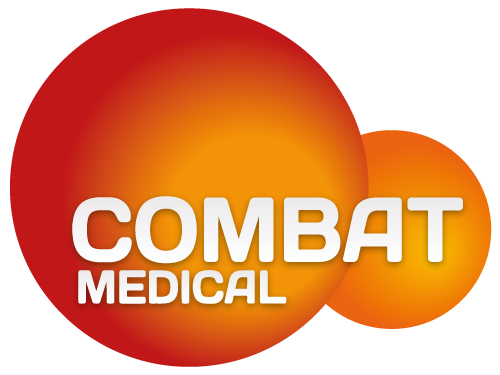
The Medical Innovators Interview with Associate Professor Ahmad Sayasneh | November 2021
The regular use of HIPEC for ovarian cancer, along with improving pre-surgical diagnostics and visualisation interoperatively, could be a real game-changer. Consultant gynaecologist, gynae-oncology surgeon and associate professor of women’s health Ahmad Sayasneh discusses all this and more in the Medical Innovators Interview with Combat Medical’s Guy Cooper.
What would you say is your primary focus?
All my work is around diagnostics and therapeutics for ovarian cancer in particular, as well as other gynae cancers. I’m a consultant gynaecologist and gynae-oncology surgeon at Guys and St Thomas’ Teaching Hospitals in London, and associate professor in women’s health at King’s College University London. My research background is in imaging diagnostics for ovarian cancer in particular, including ultrasound scans and how to characterise ovarian masses. I’ve developed that into using ultrasound scans inter-operatively, and I’m now working with other imaging departments on improving our assessment of ovarian cancer and how we can see it better during the surgery, so that we don’t miss any and can hence improve survival.
What does a standard day in theatre for you look like?
Operating from about eight till eight, three sessions, which is quite long, and I do that at least once a week. I’ll also usually have another list as well during the week. My bread and butter is ovarian cancer stage three and fertility-preserving surgery.
Now 25 years ago, surgery for late ovarian cancer meant everything out – total abdominal hysterectomy, bilateral salpingo-oophorectomy – then hand the patient over to the oncologists. What does that pathway look like today? Has it changed much?
It’s changed a lot, especially in the UK. The surgical pathway and the training have improved, and non-macroscopic disease resection has improved significantly because the training has been exposed to advances in countries like Germany and the USA. We used to call it ultra-radical surgery, then super-radical gynae surgery. But we try to avoid these terms now, because we realised that it’s all just gynae surgery. Gynae-oncology surgery involves removing the tumour at any site – not just the ovary or uterus and so on – so the resectability of the tumour has changed. Where we use to say we won’t do the operation if there is peritoneal disease, that’s now not the case. We do peritonectomy, we do liver capsule resection, we do liver resection if we have to, bowel multi-resection – that’s all now part of our gynae-oncology surgery.
Do you do this in combination with the general surgeons or is there specialist training for gynaes to go up into the abdomen?
It’s now part of our training – that’s the big jump happening in the UK. On the three lists I used to do each week while training, we didn’t have a general surgeon, a regular bowel surgeon or a colorectal surgeon. We work hand in hand with urologists if there’s an ileal conduit to do because we don’t do enough of these a year, and in cases requiring liver resection rather than liver-capsule resection, we will need a liver surgeon. Colorectal surgeons are always needed as a back-up with complex cases. It’s still up for debate whether the right thing is to do it alone or together at all times. It varies between different centres because it depends on the training. We do quite a high number of multi-visceral resection surgeries at Guy’s and St Thomas’s, so you develop your skills over time and you’d be capable of doing it, but you have to follow your Trust’s governance.
What will the general surgeons say when we tell them about gynae surgeons doing abdominal surgery?
I’m sure they’ll be surprised and probably shocked – “What is happening? Why are these people doing this?” We had a wall of ice to break and we’re still breaking it. The advice from those who’ve done it before us – and the advice I now give, too – is to invite them to your theatres, work with them and let them see what you’re doing. They have a different type of surgery for colorectal cancers, for example. Most would be inclined not to operate on colorectal cancer in the peritoneum, as it’s quite different from ovarian cancer – it’s a peritoneum disease that invades from the colon in the late stages, whereas colorectal cancer is an inside disease. By the time colorectal has got out into the peritoneum, it’s too late. There’s no place for operating unless it’s suitable for HIPEC – and there are only a few HIPEC centres in the UK.
We have a global understanding of the HIPEC super-specialty. You’ve been kind enough to visit some of our centres in Spain, where there are 50 HIPEC centres in total, and then there are 70 in Germany and Lord knows how many above a Burger King in the US. In the UK there’s Basingstoke, Christie’s… and that’s about it. Why is that?
I think it’s because we are still very defensive or over-cautious here in our practices. Remember when we first introduced magnesium sulphate as a treatment for preeclampsia? The UK coordinated the international MAGPiE trial [MAGnesium sulphate for Prevention of Eclampsia] but we were the last to introduce the treatment, even when the rest of the world was already saying, yes, magnesium sulphate works. I think it’s because there are so many formalities here, so much bureaucracy and governance. It’s not an anti-research mindset, more that everything gets quite time-consuming, and I think the problem is the same with every technology we have in the UK.
Agreed. Northern European clinical conservatism is a trope, but it’s also a fact. In Southern Europe there’s much more acceptance of new procedures in the clinical community, and that does have its pros and its cons. But it’s strange that when we go over the Channel – if we’re still allowed to go over the Channel! – all of a sudden there are 30 centres in France, whereas we have two-and-a-half here in the UK.
Indeed. It’s a very funny cycle. The reason we started the ultra-radical surgery was because we realised our numbers for survival were much lower compared to the rest of Europe. So we said, “What are we doing wrong?” And we decided, “OK, we have to expand.” And now we’re going into the circle again, saying, “Right – multi-disciplinary or gynae-oncology?” We’ve accepted the gynae oncology as a unique specialty. And it’s still going in circles because of these different opinions, which I find challenging.
Now, as a thank you for saving his life at the start of the pandemic, Boris Johnson has given St Thomas’s Hospital an open cheque for research (well, we can but dream) – whatever you want, for however much it costs. What are you going to do with it?
My area of research is improving visualisation of ovarian cancer, whether before the operation or intra-operatively, and there are two aspects to it. The first is about improving pre-surgical diagnostics, using AI to identify ovarian masses and characterise them into multi-class classifications – not only benign or malignant, but benign-malignant borderline – and then develop a support-decision machine to improve clinicians’ decision-making. I’ve also been working with the clinical biochemistry-imaging department on how to improve fluorescence intraoperatively. It’s similar to the fluorescence we use for sentinel lymph nodes, which has been on the market for a long time for vulval cancer, early cervical cancer and endometrial cancer. We’ve not been using fluorescence for ovarian cancer, partly because it’s a late cancer, but now with some advances in animal studies we’ve shown that with the right antigen you can actually find some fluorescence of ovarian cancer. So if I have the funding, I’ll invest in these two areas and they’ll go hand in hand with all the other technologies to improve survival, including HIPEC.
Tell us about HIPEC.
So imagine I’m in theatre and I’ve done the debulking or cytoreductive surgery but I’m not sure if there’s any cancer still hidden. Now you get the best outcome with HIPEC when you have no macroscopic disease, because the surgeon has resected all of the tumour – but doing that depends on the naked eye.
Yes, it’s the same for the bladder surgeons we train – the hand can’t resect what the eye can’t see, and it’s a huge problem.
Exactly. And that huge problem can be overcome by the fluorescence, because it will tell you that actually, yes, there is some cancer here. So you go for it until you have no “fluorescent-scopic” disease left behind. Then you do the HIPEC and afterwards you can repeat the fluorescence to check the difference. The implications are endless – for example, with recurrent cancers, you do the imaging and you find there is something. The PET-CT scan is telling you there’s something. You try to use your haptic sensation, you try intra-op imaging, perhaps ultrasound scanning, but you still can’t find it. Now what if there is a way of fluorescing it, of creating colour-coded surgery? Because people think that in surgery we see the tissues as separate and we can’t. I still remember being told as a medical student that veins are blue and arteries are red, and it’s not like that at all!
If we come forward one organ to the bladder, there are various technological and pharmacological products available for identifying carcinoma in situ [CIS]. Go back 25 years and urology was a very workaday specialty, but the urologists have since stolen a march. They own the robotic space. They have wonderful pharmacologic things that show them where the CIS is. Years ago, a group in Germany were working on adaptations to what were then three-chip cameras to give you a colour-coded view. Then it was based upon blood flow but we suspect there’s not a huge leap from blood flow to tumour cells.
Our project at GSTT in collaboration with Professor Garry Cook from the Clinical PET centre and Dr Ran Yan, Senior Lecturer from the Department of Imaging Chemistry and Biology, King’s College, is about labelling various cancer specific antibodies or antibody fragments with dual PET and fluorescent reports. PET/CT imaging of the malignant lesions would enable more accurate pre-operative surgical planning. During surgery, the tumours and the metastatic lymph nodes, especially the deep-lying deposits, could then be rapidly localised with a handheld radiation detector. Subsequently, fluorescence imaging would ‘light up’ these tumours for real-time assessment and more accurate resection.
So, back to your original comments about resectability for super-surgery – because it’s not about everything coming out anymore, is it? This is taking us the other way, where we’re leaving everything in. Where do you think this is going – in the next 10 years, will surgeons will be taking less or removing more?
I think we’re going in the direction of targeting. We’re better at doing less when we need to do less, especially with fertility preservation. And what helps us is being able to classify the tumour type – whether it’s borderline not as aggressive. We can do frozen-section lab work during the operation to tell us which cancer it is and whether we can do fertility preservation or not. So that helps us in doing less for certain people. Improvements in egg cryo-preservation and tissue-cryo preservation also allow us to say, “Actually, we can remove the ovary but give it to the fertility team where they can take the eggs for later on, and we can leave the uterus in.” We’re talking about uterine transplantation now. And it all goes hand in hand with less surgery, a less radical approach for certain people. But when it’s high grade, serious adenocarcinoma of the ovary with widespread disease, then we have to do more resectability.
I’ve parked the DeLorean in the car park, so let’s take you ten years into the future. What does ovarian cancer surgery in a wonderful central London teaching hospital look like in 2031?
I don’t think screening will ever work, so I’m not expecting stage three cancer to be reduced – we’ll be continuing to do the same amount of difficult, widespread cancer cases. Chemo has been there since the 1960s and I don’t see any change with the carboplatin and taxane. So the only thing I think we’ll see change is the amount of surgery we’re doing that improves the outcome. I think what will happen next is that you will have HIPEC in every single theatre where you do the primary debulking, the primary cyto-reductive surgery, then during the operation you’ll do my fluorescence technique to check for tumour cells. We won’t be saying “no macroscopic disease” anymore. We should have a definition of no disease based on a modality which will tell us that with higher accuracy – not “no macroscopic disease” according to the surgeon’s eye. Come on. That is a joke. I mean, if the patients knew about it… it’s really scary. Am I wearing my glasses? Am I using magnifying loupe glasses? This has to change.
In a 10-hour operation on a patient with a PCI [peritoneal cancer index] of 20 or 25, are you going to miss a macroscopic tumour 2mm in diameter that’s stuck in the middle of a bit of pleura on the caudate lobe where it goes into the sulcus? Of course you are. But with your fluorescence, you’ve wonderfully cleared the abdomen. Do you still need HIPEC?
Yes, of course. This is exactly when HIPEC will have its place – for the cellular, very tiny disease – and it will work better now there’s no bulk disease. And with the improvements within the HIPEC machine, it makes even more sense. Like the CO2 agitation technique for getting the chemo into all the peritoneal surfaces, rather than having to use your hand to stir the abdomen.
The days are numbered for disseminated peritoneal disease in the UK being isolated to mucinous appendix tumours and pseudomyxomas. Working with people on the cutting edge like yourself, with clinical proof obtained globally in big centres, will show patients having increased survival compared to 25 years ago – when, as you said at the start of this interview, you’d open the patient up, see the spread of the disease, close them back up and send them to the oncologist.
You’re absolutely right.
Is there anything else you’d like to do? This is your chance. You can invent the next robot. We’ve got stacks of imaginary cash (a bit like the Chancellor).
No. I think, if I can achieve 10% of that in my life, I think that would be great.

